#The Quare Fellow
Text

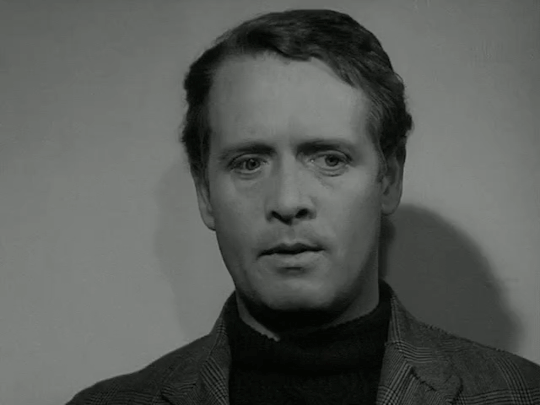
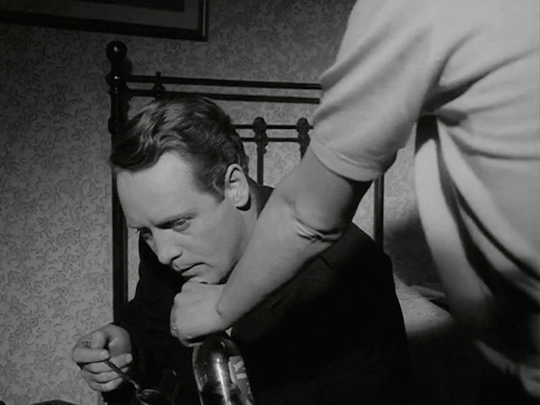


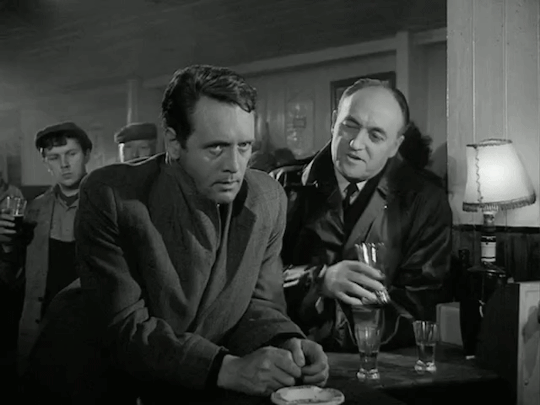
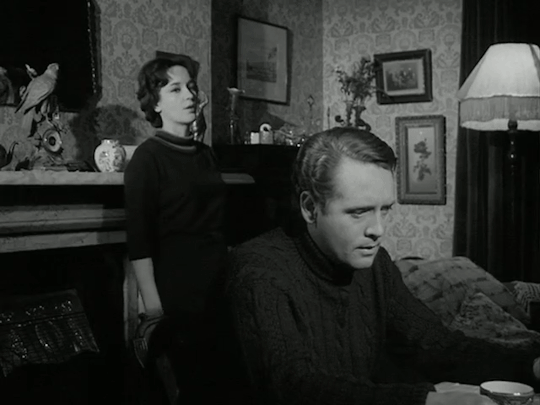



There are probably a few things McGoohan did that doesn't land him on a "Weirdo" or "Cult classics" or "Forgotten B-movies" watchlist. But this one really makes me think maybe that grumpy old man who is supposed to terrorize everyone who disturbs him mulling over a book in a bar at 6 a.m. is actually just a simple Irish guy living in a not so simple world.
57 notes
·
View notes
Text
#OTD in 1964 – Death of Brendan Behan, an Irish poet, short story writer, novelist, and playwright who wrote in both Irish and English.
He was also a committed Irish Republican and a volunteer in the Irish Republican Army. He died in Meath hospital after reportedly telling a nun looking after him: ‘Ah, bless you, Sister, may all your sons be bishops’.
Brendan Behan was born in Dublin into a republican family, and became a member of the IRA’s youth organisation Fianna Éireann at the age of fourteen. However, there was also a…

View On WordPress
#Borstal Boy#Borstal Youth Prison#Brendan Behan#Connemara#Dublin#Fianna Eireann#IRA#Irish Republican#Kerry#Novelist#playwright#Poet#The Quare Fellow#Volunteer#Writer
9 notes
·
View notes
Text
I can't stop thinking about that poor boy in The Quare Fellow. Jenkins, with the concertina and the hymn. The performance I saw of it in the Abbey was beautiful but also its how this wonderful beautiful song by a poor young boy who used to sing at street corners until he was haunted out of it because people found out his job, and his song, this song of redemption and sincerity, is weaved with the comments of the governor about the calculations of an execution. This, talk of height and weight and such as if it is not some horrible thing, and this shy boy singing. And then the young prisoner from Kerry sings for the quare fellow, because he still sees him as human despite his horrible crimes, in irish, and then the song fades away as the horror of the morning comes. I have really never seen a better argument against the death penalty as this play.
1 note
·
View note
Text
#3 Pokemon x The Ember Knight
•Probably sets in the current timeline of The Ember Knight.
• There were special forces in the Western Kingdom called the Knights, created from the medieval time and still ongoing. Basically, like the knights in The Ember Knight, but only with Pokemon and modern timeline.
• Najin, Lauzun, Luzian, and Tyr joined in, obviously. Nagyunn wanted to go on a journey, but he's poor, so he landed some job as a professor's helper, and he got it because he's super smart. Also because it was Fadiyan who took him in.
• Fadiyan was a former Knight before she retired and became a traveling professor, bringing Nagyunn with her.
• Each of the Woodion's apprentices got their starters by themselves when they were young. Since Woodion was a small village and technology wasn't so modern yet, most people there got their partners straight from the wild.
° Luzian wrestled with her soon-to-be Oshawott and won. She was drenched for a whole week.
° Tyr fed a Meowth once and it chose him to be its partner.
° Lauzun's Axew was a gift and he took care of it since it was still an egg.
° Nags found an injured Fennekin and helped her.
° Najin tried to scare off the same Torchic that had been stealing their food. It backfired, and they both were a crying mess until Nags intervened.
• The pokeballs were constructed of wood (apricorns and tumblestones), ya know, since they lived in old days. The creation of pokeballs made of apricorns was quite hard, especially in a small village like Woodion. So people tend to have one pokeball - one partner thingy.
•There were also beliefs about why everyone tends to get one pokeball other than it being totally expensive. For example, there was a belief that the first pokemon one got will affect greatly of the said person's future and their personalities. Which was why kids often only befriended the wild pokemon they met and only caught them after they were older and certain of their choice. This, of course, implies to the Woodian's apprentices and Nagyunn. Although Lauzun gotten Axew since he was very young due to private reasons.
° Luzian had a Netball, very expensive, and the last gift from her dad before he passed away. It's totally for content and not because I wanted a pokeball matched her hair colour.
° Lyamin had a Moonball. Laurun had an Ultraball.
° Wadrin got a Quickball. Also, it's not because blue and yellow pokeball fits him better.
° Masterball did not exist yet in this timeline, but Regia may or may not create it sometime in the future.
° Both Jiroon and Ludika got a Healball for their partners. Jiroon's Kirlia was a female, fyi.
° Quaring caught her Mawile by accident while it was sleeping using Dreamball. She never let Mawile go despite she didn't want it in fear it might attack her once it was free. Somehow, they bonded, though.
• Each pokemon had their own personalities. Najin's Combusken (Kē) acted tough but quick a soft hearted fellow. Nags' Fennekin (Fō) was regal and composed most of the time.
• Most of the apprentices' partners evolved during the war between the Eastern and Western Kingdom.
° Tyr's Meowth (Mian) evolved after he fought his sister's Persian.
° Wadrin's Pikachu (Peron) never evolved, though.
° Nags' Fō evolved to Braixen after they battled against Regia's Reuniclus. For whatever reason, Regia took interest in them and challenged them.
° Najin's Kē evolved to Blaziken after their battle against Laurun's Haxorus.
° Due to the fact they came from the same evolution line, Fō was quite close with Ludika's Delphox. They became even closer after she evolved to Braixen.
° Like its trainer, Zuis' Lucario was the observer in the group. Unlike its trainer who was weaker than the Knights, Lucario was strong like any other of its kind. But it was often seen laidback or simply be the referee in battles.
° Fidorance's Arcanine had numerous scars all over its body. His Arcanine was a standard war animal, yet it was often used as emotional support to those who were in need. I guess I just want to put some resemblement between Fidorance and Arcanine in emotional and personality ways.
° Previously, Bishorp didn't belong to Waron yet. It belonged to her old friend before she passed away. Waron never stated Bishorp was hers despite holding its pokeball. It often did its own thing and never bothered Waron unless there was some battling. Waron never commanded it to do something. It joining Waron in battle was its own will.
° Why am I making this when I haven't finished reading The Ember Knight yet?
Darn.
I'm so hooked up in this.
Might as well make some shorts. No promise, tho.
Anyway, any idea what Crimson Hippo Hinsher's pokemon might be? What about Candentia? Or Daljan? Or the Mother of Dragon?
Oh my gosh why am I so into this?
7 notes
·
View notes
Text
The reaction to Stoker transcribing accents/dialects is just so fascinating to me because it's really not that uncommon in older English language pop fiction. Here's a bit of The Pickwick Papers, by Charles Dickens.
‘Wery glad to hear it,’ said Mr. Weller. ‘Poetry’s unnat’ral; no man ever talked poetry ‘cept a beadle on boxin’-day, or Warren’s blackin’, or Rowland’s oil, or some of them low fellows; never you let yourself down to talk poetry, my boy. Begin agin, Sammy.’
If you're wondering what the hell kind of English accent does that v/w shift, the answer is 1830s Cockney, although apparently Dickens did miss the mark himself just a bit. George Bernard Shaw had this to say about it:
“When I came to London in 1876, the Sam Weller dialect had passed away so completely that I should have given it up as a literary fiction if I had not discovered it surviving in a Middlesex village, and heard of it from an Essex one.”
Shaw also cited James Elphinstone's translation of Martial into the phonetic Cockney of the late 1780s:
Ve have at length resoom’d our place,
And can, vith doo distinction, set;
Nor ve, the great and wulgar met.
Ve dooly can behould the play,
Sence ve in no confusion lay.
Note here Elphinstone's convention of rendering 'u' with a double 'o', which Stoker also uses. Going back to Shaw, one of the more amusing notes in the play Pygmalion is attached to Eliza Doolittle's opening line:
THE FLOWER GIRL. Ow, eez ye-ooa san, is e? Wal, fewd dan y’ de-ooty bawmz a mather should, eed now bettern to spawl a pore gel’s flahrzn than ran awy atbaht pyin. Will ye-oo py me f’them? [Here, with apologies, this desperate attempt to represent her dialect without a phonetic alphabet must be abandoned as unintelligible outside London.]
I concede that Stoker leans harder into this attempt at capturing Cockney than he needs to; yes, Thomas Bilder's accent comes across a bit cartoony. Dickens didn't lean quite as hard, and Shaw just gave up after giving an example. It just wasn't particularly beyond the pale. I mean, look at this bit of 17th century West Country dialect from Lorna Doone, published about ten years before Dracula:
“I wor over to Exeford in the morning,” John began from the chimney-corner, looking straight at Annie; “for to zee a little calve, Jan, as us cuddn't get thee to lave houze about. Meesus have got a quare vancy vor un, from wutt her have heer'd of the brade. Now zit quite, wull 'e Miss Luzzie, or a 'wunt goo on no vurder. Vaine little tayl I'll tull' ee, if so be thee zits quite. Wull, as I coom down the hill, I zeed a saight of volks astapping of the ro-udwai. Arl on 'em wi' girt goons, or two men out of dree wi' 'em. Rackon there wor dree score on 'em, tak smarl and beg togather laike; latt aloun the women and chillers; zum on em wi' matches blowing, tothers wi' flint-lacks. 'Wutt be up now?' I says to Bill Blacksmith, as had knowledge of me: 'be the King acoomin? If her be, do 'ee want to shutt 'un?'
Note that R. D. Blackmore was dead serious about capturing this dialect. He did intensive, painstaking research. The point was not to mock these characters, it was to try to capture, through language choices, a spirit and mood particular to a time and place. It matters who has this dialect and who doesn't in the narrative.
While Stoker didn't have such lofty ambitions, don't think the point is to mock either. I think it's Stoker trying to do the old 'capturing local colour' thing. He wasn't alone in that. Off the top of my head, Sholem Aleichem transcribed a Jewish German's accent phonetically in some story whose title escapes me in order to differentiate him from the Eastern European Jewish characters with whom he identified.
I've seen people hammer Brian Jacques (a much more modern writer) for the same thing Stoker's doing, and I guess it's just been normalized for me. Do know if you go on reading fiction from the place and period-- especially pop fiction not intended as high art, like Dracula-- you will encounter more of this kind of thing. It was a convention. Conventions come and go.
#dracula daily#comparative literature#dracula daily meta#long post#incidentally 'atbaht' seems to be a misrendering of 'athaht'#but i'm going with what's written on the project gutenberg version
85 notes
·
View notes
Text
"Fun Palaces," then and now
In 1961 Joan Littlewood and Cedric Price designed a Fun Palace building – a ‘laboratory of fun’. They imagined a building linked through technology to other spaces, accessible to those who wouldn’t normally go to arts venues or great centres of learning.
Joan said, “I do really believe in the community. I really do believe in the genius in every person. And I’ve heard that greatness come out of them, that great thing which is in people.”
The original design said:
“Choose what you want to do – or watch someone else doing it. Learn how to handle tools, paint, babies, machinery, or just listen to your favourite tune. Dance, talk or be lifted up to where you can see how other people make things work. Sit out over space with a drink and tune in to what’s happening elsewhere in the city. Try starting a riot or beginning a painting – or just lie back and stare at the sky.”
Unfortunately that ideal space was never created, although there were a few incarnations of potential Fun Palaces, Joan’s Stratford Fair in 1975 among them. In 2013 we re-imagined Fun Palaces as a space that any of us could create, wherever we live – championing more equitable uses of the under-used buildings and spaces we already have and genuinely community-led. There’s a blog about how our version started here.
This first imagining was simply as a celebration of Joan’s centenary – what we didn’t know in 2013 was how many people would be excited by this idea and how many communities would take it on and make it their own, helping us grow it into a campaign for cultural democracy and the annual Weekend of Celebration it has become – local people sharing skills, creating tiny revolutions of connection.
Stanley Mathews has a great piece about the original Fun Palace design here.
Joan Littlewood, Theatre Director (1914-2002)
Joan was born in South London on 6 October 1914, she died in 2002. At eighteen she won a scholarship to RADA and, having left drama school early, she walked from London to (almost) Manchester to get away from the constraints of 1930s London theatre. In Manchester she met Ewan MacColl. They worked with actors and writers, making dynamic and provocative work. Following political activism during the Spanish Civil War and WW2, the company reformed as Theatre Workshop. In 1946, they were invited by Ruth Pennyman to live and work from Ormesby Hall, which they did for eighteen months. The company toured and worked together, developing the Laban-based movement work and ensemble that became their hallmark. At the end of 1952 the company decided to return to a settled base. MacColl chose to stay in the north, Theatre Workshop moved to Stratford.
The Theatre Royal Stratford East was a dilapidated palace of varieties when Littlewood and her partner Gerry Raffles took it over in January 1953. The company renovated the building and Joan’s great causes – community and political theatre, improvisation, the working class language, the inclusion of children – helped change the face of British theatre.
She had numerous hits, most notably Oh! What A Lovely War, Fings Ain’t What They Used To Be and A Taste of Honey. Her production of Brendan Behan’s The Quare Fellow brought Behan international acclaim. Joan worked with many artists at the start of their careers, people who later became household names including Barbara Windsor, Harry H Corbett, Lionel Bart, Victor Spinelli and Murray Melvin....
3 notes
·
View notes
Text
Mission understood.
I shall write fanfic for my fellow Quaritch simps.
How about part 1 is human Quar hunting you down
And part 2 is him returning - to kill sully and bring you back to him.- even if he isn’t the ‘Quaritch’ who claimed you. He’ll be the last one to- ;)
13 notes
·
View notes
Text
GLANCES OF LOVE AND MALICE.
"AMOR ex Oculo": Love is from the eye: but (as the Lord Bacon saith) more by glances than by full gazings; and so for envy and malice.
Tell me dearest, what is Love ?
'Tis a Lightning from above:
'Tis an Arrow, 'tis a Fire,
'Tis a Boy they call Desire.*
* Mr. Fletcher in Cupid's Revenge.
'Tis something divine and inexplicable. It is strange, that as one walks the streets sometimes one shall meet with an aspect (of male or female) that pleases our souls; and whose natural sweetness of nature, we could boldly rely upon. One never saw the other before, and so could neither oblige or disoblige each other. Gaze not on a maid, saith Ecclus. 9, 5.
The Glances of envy and malice do shoot also subtilly; the eye of the malicious person, does really infect and make sick the spirit of the other. The Lord Bacon saith it hath been observed, that after triumphs, the triumphants have been sick in spirit.
The chymist can draw subtile spirits, that will work upon one another at some distance, viz. spirits of alkalies and acids, e.g. spirits coelestial (sal armoniac and spirits of C. C. will work on each other at half a yard distance, and smoke;) but the spirits above mentioned are more subtile than they.
"Non amo te Sabati, nece possum dicere quare,
Hoc tantum possum dicere, non amo te".
Fellow, I love thee not, I can't tell why,
But this, I'll tell thee, I could sooner die.
But if an astrologer had their nativities, he would find a great disagreement in the schemes. These are hyper-physical opticks, and drawn from the heavens.
Infants are very sensible of these irradiations of the eyes. In Spain, France, &c. southern countries, the nurses and parents are very shy to let people look upon their young children, for fear of fascination. In Spain, they take it ill if one looks on a child, and make one say, God bless it. They talk of "mal de ojos". We usually say, witches have evil eyes.
- John Aubrey
8 notes
·
View notes
Text
The Quare Fellow shows up in 🇧🇪
instagram
8 notes
·
View notes
Text
Transcript of the first and second page:
From all that I gathered of the Grand Masters, almost all known names have an according biography. Or at least the have been mentioned by another Grand Master or other source in history. The few no one ever bothered writing down are the ones I've been asking the internet to help me out with, but, as you can see, I am nowhere closer to an answer. Someone pointed out that two of these guys' last names start with L and V, and this could be *tinfoil alarm* short or Lux Veritatis. Perhaps they were not members during the highest time of the Templars but rather the aftermath. I took a look into the history of the order to find more about the group rather than the individuals.
The name of the Knight's Templars was "poor fellow soldiers of Christ and the Temple of Solomon" which was long as heck and is not as remembered today. Their signature look instead is.- a red, thick cross with serifs on each end and quare in size. They were Christians with two main tasks set upon themselves:
to protect Christian pilgrims and European travellers on their way to the Holy Land and
to expand the Christian belief in the world.
In 1099 Christians captured Jerusalem after besieging the city and this made pilgrims travel there. Since Christians and Muslims didn't get along a lot of people got raided on their way there or even hurt or killed. To protect them was an ideal reason to make the club of the Templars.


Transcript of the third page:
In 1118 Hugues de Payens whose picture we have seen earlier created the order with eight of his relatives. In Jerusalem there was a current ruler named Baldwin II, who supported the Templars and provided a place for their headquaters. These were in the city's sacred Temple Mount, hence their short name became Templar's. The Pope was not too fond of them yet supported it somewhat in 1129, finding the idea of conquering the world in a Christian way appealing. He even granted the Templars special rights:
they didn't have to pay taxes
they were allowed to build own oratories and
they were only under the Pope's personal authority.
On the fourth page once can see the typical armor of a Templar. This white cloak had a red cross on the chest and on the back, also the shield was painted in these colors. The rest of the armor was pretty much a typical knight's armor.
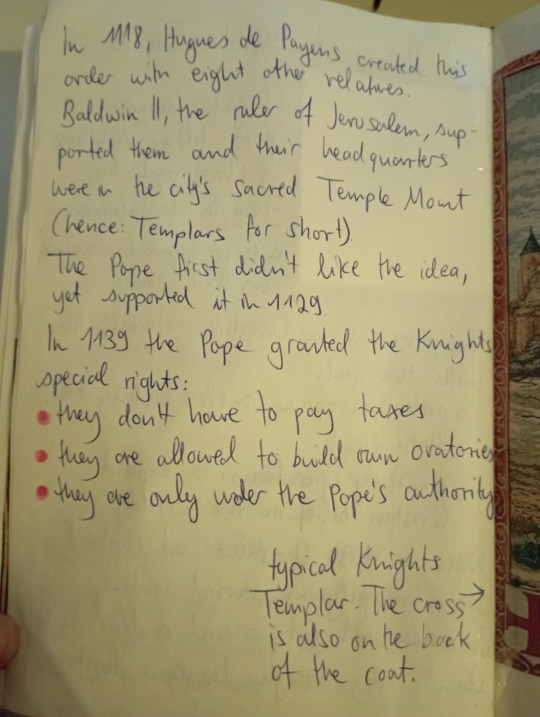

Transcript of the fifth and sixth page:
The Templars had a system almost like banks today: pilgrims could deposit any amount of money in their home cities and once reaching Jerusalem they were able to withdraw these funds- like an ATM machine. This made them also popular with regular travellers and even merchants as their wealth was secured.
As a Knight's Templar one had to follow certain rules. They were far too many and I have four pages full of them. I'll note the strangest here, you can read the others on the pictures.
there was one reason to rise earlier from the dinner table: a fire, a war cry or, strangely, nosebleeds
their clothing during times where they wouldn't go to war or outside had to be white, black or brown
not allowed were also pointy shoes (not sure if too witchy) and shoelaces (?)
they were not allowed to attack anyone despite being warrior monks unless a Christian was attacked
beards were cool when long, but long hair wasn't (too womanly)
gambling was suprisingly allowed but only with another brother with his crossbow or ten candles
Yeah don't asked me about the sense, I just distract myself from the outside world. It's good to know strange and crazy people always existed so today feels more...normal. Or at least, okay.

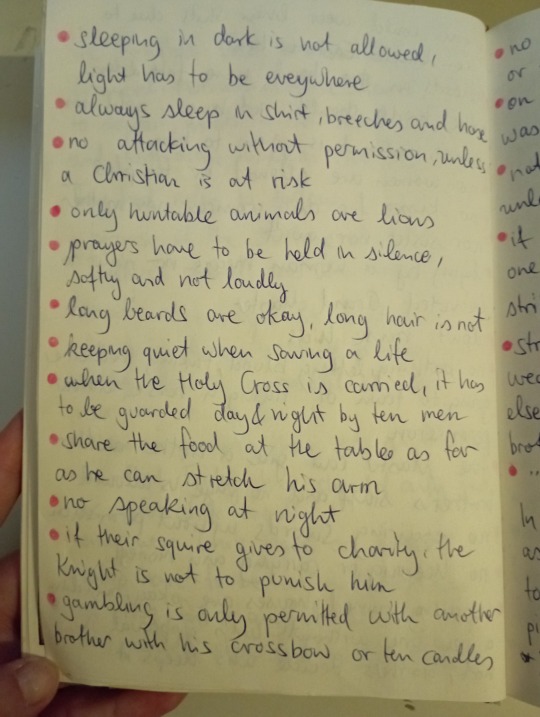
Transcript of the seventh page:
Here I have the summary on the Templars. Molay, the guy you remember, was burned with a friend on the stake and the order was dissolved in 1312. The Knight's Templars were officially gone and the Pope was anti, yet a lot of people suspected them to go underground and exist to this day. Officially, they don't, yet another group named the Freemasons revived their traditions.
Some questions arose during my research: if they really went underground, where to? Who are the Freemasons, could they be a spin-off? Or an unofficial continuation of the order?

The Freemasons were officially mentioned in 1445, that's 133 years after the Knight's Templars were wiped out. So they are not really connected or at least pretend they are not. Either way, I will look into the Freemasons now. No mention of Vasiley or Limoux. I might be even incorrect with these guys, I'm not sure. But anything is better than just listening to the radio and hearing more shops closing temporarily, more police patrolling the streets and Paris even contemplating a lockdown to protect us from the monstrum.
#tomb raider#angel of darkness#traod#classic tr#tomb raider angel of darkness#journal#aod#lara craft#tomb raider series
2 notes
·
View notes
Text
I’ve had a good last few days, I visited family in Dublin and while there saw some but nowhere near all of Dublin’s many Theatre’s I took a photo of some I saw mostly to remember which one’s I came across.
In the evening I went to see The Abbey’s production of The Quare Fellow I was quite happy to see an in house production as outside of London I’m mostly seeing tours. It was a play that did a lot which a little and the lighting really was exceptional, the actors where all knocking it out the park and I really did enjoy the one major scene transition. The whole show is set in a prison so pretty minimalist by necessity an yet they still went above and beyond for detail. My family member who w=is a fan of the playwright Brendan Behan told me about him and showed me his old place with a plaque when we where driving past and I learned more about him from the program.
The day after I went to the zoo which was pretty quite had a great veggie burger and got to see way more of the animals than i usually do because it was so quite.
After that I visited The Museum of Decorative Arts & History Ireland watched their stuff on Eileen Gray and skimmed the exhibits.
Once I got home I had a tour of Glasgow King’s Theatre lined up and got to see the behind the scenes of the Shrek Musical I’d seen only a few days earlier and learn even more about the building,
During Shreck i noticed the front screen was doubling visuals for aboult half a meter in the center making me wonder what type of screen it was as it was most certainly not a fron on projector though i did see what looked like a projector up in the fly system.
I got to see the back screen was what they called Shrek’s Massive Telly but i didn’t fully figure out the deal of the front drop down screen the guide said it was probably just a similar sort of screen to the back one but on the fly but only the crew would know so now I’m considering being that person who messages asking for info I don’t need for anything in particular.
Overall I’ve had a good week and hope the break means I’m rested and ready for my interview to get into my dream course.
1 note
·
View note
Text
#OTD in 1923 – Birth of poet and playwright, Brendan Behan, in Dublin.
Much of Brendan Behan’s work was autobiographical, showcasing working class, Republican Dublin. He is widely regarded as one of the greatest Irish writers and poets of all time. Born in Dublin into a republican family, he became a member of the IRA’s youth organisation Fianna Éireann at the age of fourteen. However, there was also a strong emphasis on Irish history and culture in the home, which…

View On WordPress
#Activist#Borstal Boy#Brendan Behan#Dominic Behan#History of Ireland#IRA#Ireland#Irish History#Kathleen Behan#Michael Collins#Peadar Kearney#playwright#Portrait by Mark Baker#songwriter#The Auld Triangle#The Quare Fellow
21 notes
·
View notes
Text
watched a cross-cast version of brendan behan's the quare fellow and while im not entirely sure what the cross-casting was meant to add to the play meaning-wise, i did immensely enjoy the drag performance it basically was half the time
#some of the actresses clearly had a lot of fun with it#i mean the play is already written to kind of be an exaggeration of performed manliness in prison#so having women play all the characters kind of underlined the fact how much of an performance it is half the time#anyway#emma talks
0 notes
Text
PRISONER D: He should be taken up for that. According to that man, there should be no such thing as law and order. We could all be murdered in our beds, the innocent prey of every ruffian that took it into his head to appropriate our goods, our lives even. Property must have security! What do you think society would come to without police and judges and suitable punishment? Chaos! In my opinion, hanging's too good for 'em.
Brendan Behan, The Quare Fellow
0 notes
Text
ABOUT POST ESDA REVOLUTION AND THE CONTRIBUTION IN PHILIPPINE LITERATURE.
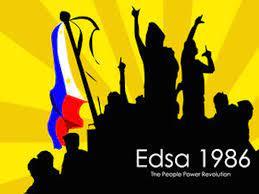
The year 1986 marks a new beginning of a new scene for Filipino writers and artists. It saw the downfall of late President Ferdinand Marcos when he placed the Philippines under martial rule last September 21,1972. This action does not only oppress the writers' right to free expression but also created conditions that made collaboration and cooperation convenient choices for artists' struggling for recognition and survival. Furthermore, the growth of underground writing was created both in urban and in the countryside.
The popular "Edsa Revolution" (EDSA, a highway in Metro Manila that runs north to south from Caloocan to Baclaran) has paved the way for the flight of the dictator and his family to Hawaii, USA on February 24,1986. The revolt established the presidency of Corazon Aquino, which marked the "restoration" of a pre-Martial Law society. However, the Philippines did not recover that easily. The years that followed "Edsa" was a wild "roller-coaster" ride for many Filipinos. The unease times was caused by natural disasters that left the economic plans in shambles.
Militancy and belligerence best describes writing under the Martial Law regime. With the overthrow of the enemy in 1986, however, the literary activity showed certain disorientation manifesting itself in a proliferation of concerns taken up by individual writers and groups.
Creative writing centers after Edsa maybe grouped into two. Academic institutions where Creative Writing is part of the curricular offerings, and students majoring in Literature are able to come in contact with elder creative writers/critics/professors belonged to the first group. Such academic institutions includes the Silliman University; the University of the Philippines; the Ateneo de Manila University; De la Salle University; and last but not the least, San Carlos University in Cebu.
The second group is composed of writers' organizations that periodically sponsor symposia on writing and/or set up workshops for its members and other interested parties. UMPIL (Unyon ng mga Manunulat ng Pilipino), PANULAT (Pambansang Unyon ng mga Manunulat), Panday-Lipi, GAT (Galian sa Arte at Tula), KATHA, LIRA (Linangan sa Imahen, Retorika at Anyo), GUMIL (Gunglo Dagiti Mannurat nga Ilokano), LUDABI (Lubas sa Dagang Binisaya) and P.E.N.
Writers get to hear about new developments in writing and derive enthusiasm for their craft through these twin centers. The two "unyon" function as umbrellas under which writers belonging to a diversity of organizations socialize with fellow writers.
Award giving bodies, annual competitions and publications provide the incentives for writers to keep producing. These actions perform the important service of keeping the writers in the public consciousness, making it possible for commentators and audiences to identify significant established writers and give attention to emerging new talents.
The National Commission on Culture and the Arts (NCCA), a post-EDSA state sponsored institution, was created by the law in 1992, superseding the Presidential Commission on Culture and the Arts which was established in 1987. The said institution has a Committee on Literary Arts which funds workshops, conferences, publications and a variety of projects geared towards the production of a "national literature". The committee has the aim of developing writing that is multi-lingual, multi-cultural, and truly national.
Non-governmental organizations have helped hand in hand with some institutions in giving recognition to writers from specific sectors in the society. These NGO's includes the Amado V. Hernandez Foundation; the GAPAS foundation, and the KAIBIGAN.
Campus publications are another group of outlet that is of importance as a source of non-traditional, experimental writing. These campus publications could either be a weekly student newspapers, quarterly magazines, or annual literary journals. The University of the Philippines has the Collegian; The Diliman Review; and The Literary Apprentice. Silliman University has Sands and Coral; Ateneo de Manila University issues Heights and Philippine Studies; De la Salle University has Malate, Likha, and Malay to offer; University of Santo Tomas publishes The Varsitarian.
Overall, the character of the Philippine literary scene after "EDSA" maybe pinpointed be referring to the theories that inform literary production, to the products issuing from the publishers, to the dominant concerns demonstrated by the writers' output, and to the direction towards which literary studies are tending.
1. There is in the academe an emerging critical orientation that draws its concerns and insights from literary theorizing current in England and the United States.
2. Post-EDSA publishing has been marked by adventurousness, a willingness to gamble on "non-traditional" projects.
3. The declining prestige of the New Criticism, whose rigorous aesthetic norms has previously functioned as a Procrustean bed on which Filipino authors and their works were measured, has opened a gap in the critical evaluation of literary works.
4. The fourth and final characteristic of post-EDSA writing is the development thrust towards the retrieval and the recuperation of writing in Philippine languages other than Tagalog.
The effect of post edsa revolution contributes to the philippine literature, because of death Ninoy Aquino in 1983 , the temper of poetry and theatre derived much its heat and direction from the political culture of underground national democratic movement. Due to this incident the impact of his death made people more literate.
SOURCE:https://www.slideshare.net/JessPalo1/litt-1-report
0 notes
Text
Irland ohne rettenden Schirm

(Der Beitrag wurde erstmals im Februar 2014 veröffentlicht)
Dublin - Eine Art Halali verkündet die pünktliche Landung von ryanair in Dublin oder ist es Verkaufsjubel? Kurz vorher ließ sich das mit Reisebuch und Internet-Recherchen präparierte Ehepaar auf den Nebensitzen die teuren aircoach-Tickets für die Busfahrt in die Stadt aufschwatzen. Die kosten mehr als das dreifache einer Fahrt mit dem Linienbus, und vielleicht hätte ich sie warnen sollen, aber Irland, das gerade den Rettungsschirm verließ, braucht jeden Cent.

rain, rain... Foto: Beate Lemcke
Aufgekratzte Stewardessen reden einem jungen Mann zu, den halbvollen Trinkbecher nicht in der Maschine zurückzulassen, sondern auf die Heimkehr zu leeren: Cmon, one more sluug, an anodder wii drop... Brav trinkt er aus, dann wankt der Lädierte im Schneckentempo mit Klammergriff am Geländer die Gangway runter.
Auch meine Ankunft gestaltet sich suboptimal. Beim Chipper zieht mir die genervte Bedienung den Teller trotz bereits im Fisch steckender Gabel wieder weg, wegen Verwechslung. Das neue Mahl sieht blass aus und wird erst genießbar, nachdem ich Fisch und Chips nochmal ins Öl werfen ließ. Mein jahrelanger innerer Kampf ist vorerst entschieden: Goodbye, "Beshoff", ich bin ab jetzt Stammkunde bei "Leo Burdock". Selbstverständlich muss ein Fisch schwimmen, was sich mit der Idee vom Begrüßungs-Pint of Guinness deckt. Später wird der Bronze-James-Joyce auf der Earl Street North Zeuge, wie ich der Zechprellerei bezichtigt werde. Das hat man davon, wenn man nach alter irischer Sitte sofort zahlt.

Green is more... Foto: Beate Lemcke
Eingehüllt in den besonderen Sound Dublins mit seinen mövendurchkreischten Morgen mache ich mich auf zum Friedhof von Glasnevin. Brendan Behan, dessen Grab ich dort besuchen will, hat dem Royal Canal, den ich zunächst queren muß, ein Denkmal gesetzt mit seiner Interpretation von “The Auld Triangle” (verfaßt von seinem Bruder Dominic für Brendans Theaterstück “The Quare Fellow”).
Die schwer befahrene Whitworth Road verläuft parallell zur Wasserstraße und weist nur auf einer Seite einen Fußweg aus. Ausgerechnet auf der anderen mahnt ein Verkehrsschild "Caution blind people training". Das läßt ungute Gedanken an sadistische Spiele aufkommen, aber in der Nähe gibt es eine Institution für people with sight loss, und für die ist der schreckensreiche Trainingsparcours wohl gedacht.
Blumenläden und einige Vorgärten zeugen davon, daß das Alpenveilchen in Irland gerade eine Renaissance erlebt. Ausgerechnet diese vergessenen Pflanzen, derer – zumal im Osten Deutschlands – viele überdrüssig sind, waren sie doch über Jahrzehnte neben der Nelke die einzige florale Zier, an der kein Mangel herrschte.
In das Licht der tiefstehenden Januarsonne getaucht ist der Friedhof von Glasnevin schlechthin überwältigend. Die Weite, die Größe, der urtümliche Baumbestand!

Augenbaum auf dem Glasnevin Cem. Foto: Beate Lemcke
Es braucht eine Weile, bis ich das ungeschmückte Grab von Brendan Behan gefunden habe.
Noch länger allerdings soll es dauern, als ich mich am Folgetag auf die Suche nach der Grabstätte meines irischen Lieblingsautors Flann O'Brien begebe, für dessen Theorie vom Molekülaustausch Mensch-Fahrrad ich schon häufig Belege gefunden zu haben glaube. Dass sie so schwer zu lokalisieren ist, liegt erneut an der Schmucklosigkeit der Ruhestätte. Und an des Meisters Pseudonymen. Soll ich nun nach Brian Nolan suchen, nach Brian O'Nolan, nach Flann O'Brien oder Myles na gCopalleen oder Gopaleen? Der Friedhof, ca. 12 Kilometer südlich von Dublin gelegen, ist noch größer als der in Glasnevin. Dafür weniger grün, graue Grabfelder soweit das Auge reicht. Schließlich stehe ich neben dem unscheinbaren Familienstein der Ó Nuallain's, auf dem auch der Name Brian vermerkt ist und daß er 1966 verstarb. Nichts aber über seine Begabung ("So hätte Joyce geschrieben, wenn er nicht bescheuert gewesen wäre"), kein Blümchen, nicht mal ein Alpenveilchen, nichts.
Ich bin froh, vorgesorgt zu haben und kippe einen guten Tropfen Whiskey auf seine "Schulter", um dann selber einen Schluck zu nehmen, der Brisanz meiner Unternehmung angemessen.
Im Café am Friedhofstor drängt mich die warmherzige Bedienung, zwei alten Herrschaften zu erzählen, was ich am Grab gemacht habe. Die freuen sich, und der Herr zitiert sogleich aus The workmans friend : "When things go wrong and will not come right, Though you do the best you can, When life looks black as the hour of night - A pint of plain is your only man".

Schuluniform. Foto: Beate Lemcke
Die fragile Greisin weiß zu berichten, dass sie zuweilen zuschauen darf, wie Brians jüngster Bruder Micheál mit Regenschirm durch Dun Laoghaire spaziert.
Später im Sweny, wo Leopold Bloom seine Lemon-Seife für Molly kaufte, erfahre ich von einem der Joyceaner, daß dieser ab und an O'Nolans Nichte Roisin in Dublin trifft. Er will ihr von meiner Whiskey-Attacke erzählen. (Tut mir ja selber leid, daß ich nicht des Dichters Lieblingstropfen Middleton dabei hatte...)
Übrigens war mir auf dem Rückweg aus Blackrock zum wiederholten Male aufgefallen, daß ich bei religiösen Slogans in Irland schwer zu ergründen vermag, ob etwas Ernst, Nonsens oder Ironie ist. So las ich an einer St. Thomas Kirche "Jesus is my rock and I am ready to roll!" (?)

Ende einer Institution an der Frederick Street Nth. Foto: Beate Lemcke
Ins Burdock in Temple Bar komme ich an meinem letzten Tag in Dublin gerade noch rechtzeitig, um einen Streit zu schlichten. Die Jungs am Frittiertopf diskutieren, was wohl die Hauptstadt von Deutschland sei – München oder Frankfurt. Ihr Herz immerhin scheinen sie am rechten Fleck zu haben, denn fürs Restgeld steht eine Schale auf dem Tresen "donations to kill Justin Bieber".
Für mich geht es weiter nach Norden, und nun brauche ich doch einen Regenschirm.
Beate Lemcke (Januar 2014)
Beate ist nicht nur eine begnadete Autorin und ausgezeichnete Irland-Kennerin, sondern sie ist auch Inhaberin des Szene-Ladens Irish Berlin, Große Hamburger Straße 36A, 10115 Berlin.
Titelfoto / Nahe Aungier Str. / Foto: Beate Lemcke
Noch mehr Fotos:

Glasnevin lädt zum Spaziergang. Foto: Beate Lemcke

Idylle in Phibsborough. Foto: Beate Lemcke
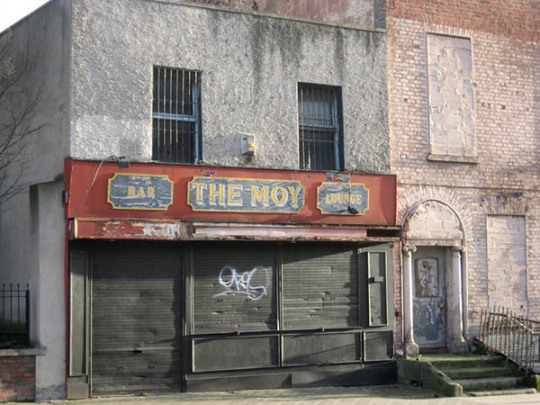
Im Norden Dublins, wie eine Western-Kulisse. Foto: Beate Lemcke

Irische Tür. Foto: Beate Lemcke
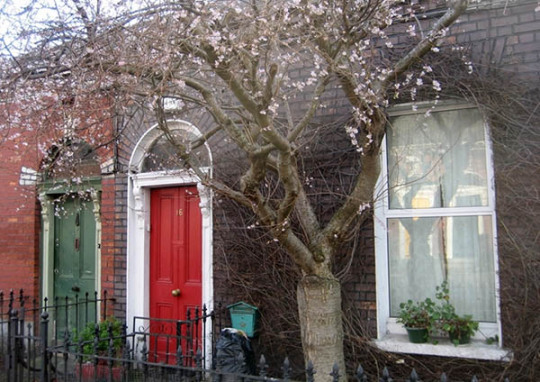
Foto: Beate Lemcke

Foto: Beate Lemcke

Foto: Beate Lemcke

Philip Lynott. Foto: Beate Lemcke

Stephen's Green Centre. Foto: Beate Lemcke

Brendan Behan, Glasnevin. Foto: Beate Lemcke

Brian Nolan, Dean's Grange Cemetery. Foto: Beate Lemcke

Dean's Grange Cemetery. Foto: Beate Lemcke
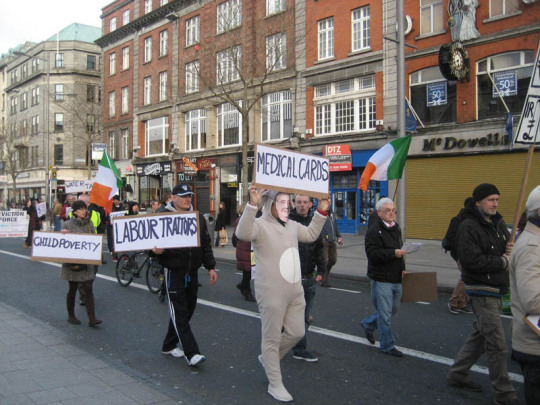
Demo in der O'Connell Street. Foto: Beate Lemcke

Diese Tür ist zu...
Foto: Beate Lemcke
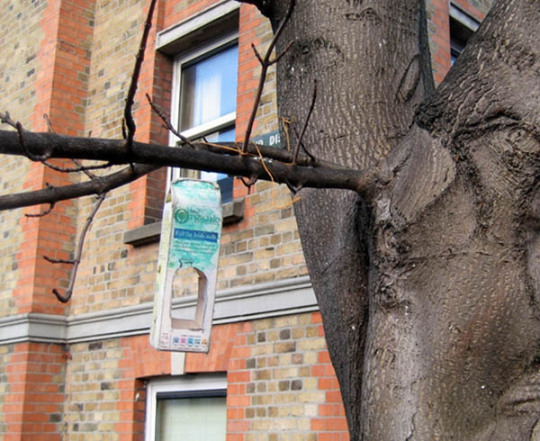
ein Tetrapak wird Vogelhäuschen. Foto: Beate Lemcke

Foto: Beate Lemcke

Ende einer Institution an der Frederick Street Nth. Foto: Beate Lemcke

Fahrrad-Ersatzteillager. Foto: Beate Lemcke

Glasnevin Cemetery. Foto: Beate Lemcke

Caution. Foto: Beate Lemcke
Auch interessant:
Read the full article
0 notes